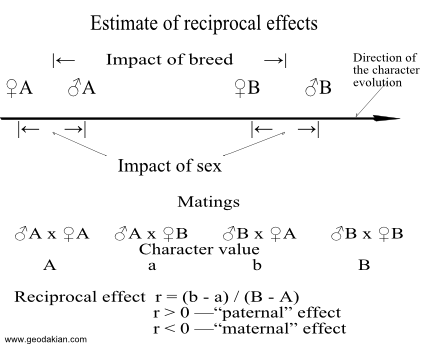|
The Evolutionary Theory of
Sex:
“Paternal Effect”
  
“Paternal Effect” helps explain centuries-old biological
observation that both mule and hinny look closer to their
fathers.
Some characters belong to one sex
only (primary and secondary sexual traits, many useful
characters—egg, milk, caviar production). Because phenotype
of one sex lucks the character, one can judge genotypical
sexual dimorphism by reciprocal effects. It follows that
while with “old” stable characters the genetic contribution
of father to the offspring is somewhat smaller than that of
mother due to maternal effect stipulated by cytoplasmic
inheritance and uterine development, with “new”,
evolving characters paternal contribution must exceed
the maternal one. This may result in the compensation of
maternal effect for such characters and even in the
initiation of opposite “paternal effect”. In other words,
when “new” characters are transmitted paternal characters
must to some extent dominate over the maternal ones.
Reciprocal “paternal” effect allows
distinguishing the character that undergoes evolution from
the stable one. The direction of character evolution can be
determined based on genotypical sexual dimorphism and
heterosis.
Hence considering heterosis as a sum
of new evolutionary achievements acquired through divergence
it can be suggested that paternal contribution to heterosis
must exceed the maternal one. In the light of new views, it
becomes clear why in heterosis we, as a rule, observe
increasing of the characters useful for the human, but not
for the species itself. In addition, this phenomenon is
independent of species undergoing heterosis. Heterosis gives
nothing to the species and can be even unhealthy. But since
selection can be considered as human-forced artificial
evolution for those species, the direction of this evolution
and the direction of heterosis are in accordance with
human’s interest, but not with the interest of the
particular species.
Considering evolution of the character in Phylogeny as
some kind of an abstract “movement”, one can speak about a
“distance” between male and female sex on this character.
Suppose that an initial form diversified in
Phylogeny into
two different forms (breed, line or race) by this
character. Then, according to “phylogenetic rule of sexual
dimorphism,” we can expect that males from both forms (A
and B) should be more advanced compare to females. So, one
can speak about the
“distances” between breeds according to the trait (how fare
they are gone from each other) and between males and females
within each breed (Figure). It’s possible to
distinguish the “impact of breed” and “impact of sex” in
hybridization. The effect of heterosis can tell about the
“distance” between the breeds and sexual dimorphism—about
the “distance” between the sexes. The direction (“maternal”
or “paternal” effect) and value of reciprocal effect can
tell about divergent or convergent evolution of the
trait. Therefore appears a
possibility to explain more completely the reciprocal
effects, which are nothing more
but the vector sum of maternal and paternal effects.

The following formula can be used for
measurement of reciprocal
effects (r): r = (b - a) / (B - A), where A and B
—are values of the
character for the initial forms; a —the same for
hybrid ♂A x ♀B; b —for
reciprocal hybrid ♂B x ♀A. Then positive value of r
(r > 0) will correspond to
“paternal” effect, negative (r < 0)—to
“maternal”. Absolute value of r (│r│) will provide relative measure
of the effect in units (B - A).
What characters can be classified as
the “new” ones, as those being in evolutionary process? In
humans “new”, evolutionary young characters are all social,
psychological characters related to the large hemisphere
cortex of the brain, to the brain functional asymmetry
(first of all, apparently, abstract thinking, spatial
vision, humor and other creative abilities). In agricultural
animals and plants, these are evidently all economically
valuable characters, which are selected by man artificially
and according to its goal. In animals these characters are
early maturity, productivity of meat, milk, eggs, wool etc.
Consequently, one could expect that all economically
valuable characters are connected with “paternal effect”,
i.e. the character of father's breed or line dominates over
the mother's one.
Hens:
The “paternal effect” was observed on brooding instinct,
early maturity of daughters, egg laying capacity, and live
weight
“Maternal effect” was observed on the weight of eggs.
Pigs:
The “paternal effect” was observed on the characters for
which the selection took place: the vertebra number
(selection for long body), the length of small intestine
(selection for best food utilization) and growth dynamics
(selection for early maturity).
The “maternal effect” was observed
for the weight of newborn piglets.
Cattle:
The “paternal effect” was observed on milk yield and fat
production (amount of fat).
Small “maternal effect” is observed for the percentage of
fat in the milk.
Large father's contribution to the
egg yield of daughters was explained by the fact that in
hens the female is heterogametic and the male—homogametic,
therefore its single X-chromosome the hen receives from its
father (Morley, Smith, 1954). If so, it should be expected
that in mammals everything must be vice versa, since their
males are heterogametic, i.e. greater contribution must be
observed, notwithstanding the fact, whether an “old” or
“new” character is inherited. According to new theory,
disregarding the gamete pattern of sexes, in all
cases the “paternal effect” for evolving (selected)
characters must exist.
Back
to
Sexual Dimorphism—Forms
More about
“Paternal Effect”:
Existence of the “Paternal Effect” in the Inheritance of
Evolving Characteristics.
Geodakyan V. A. Doklady Biological Sciences, 1979, v.
248, N 1-6, p. 1084–1088. Translated from Doklady Akademii
Nauk, Vol. 248, No. 1, pp. 230-234, September, 1979.
Evolutionary Logics of Sex Differentiation. Reaction Norm,
Sexual Dimorphism, "Paternal Effect".
Geodakian V. A.
|